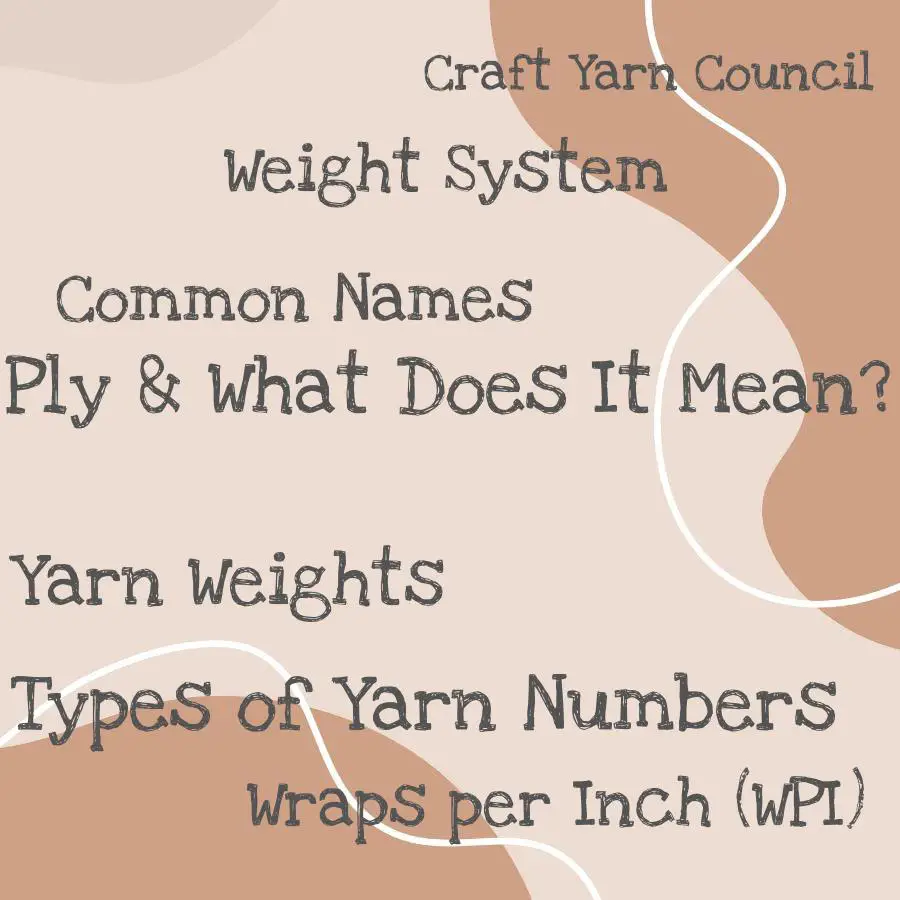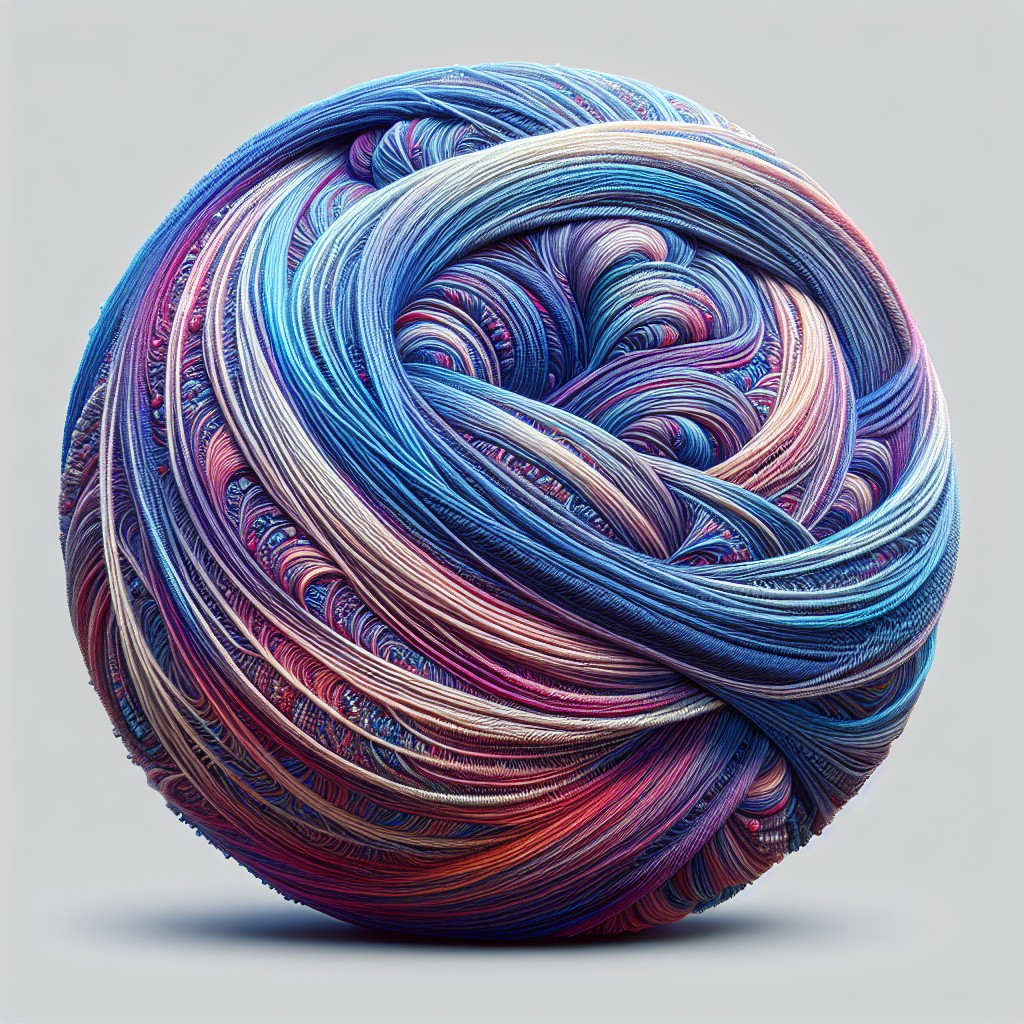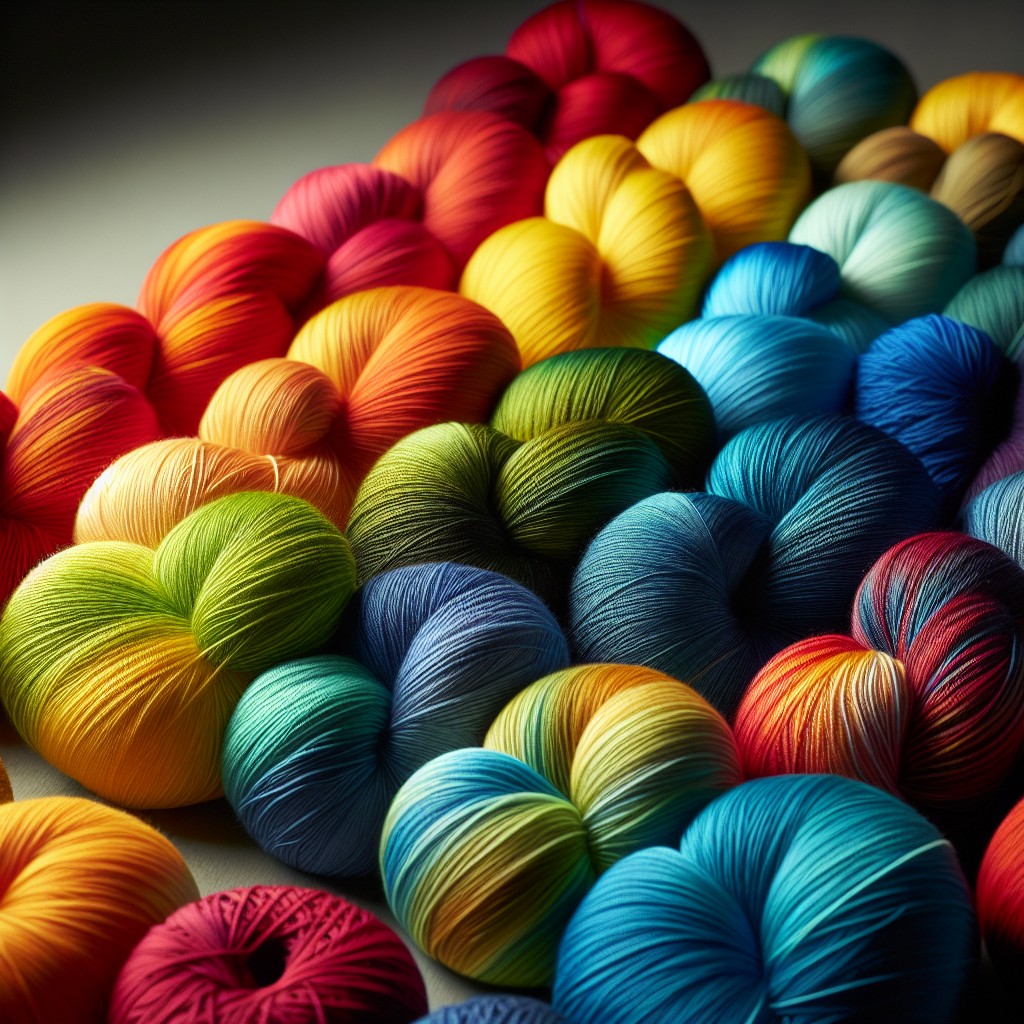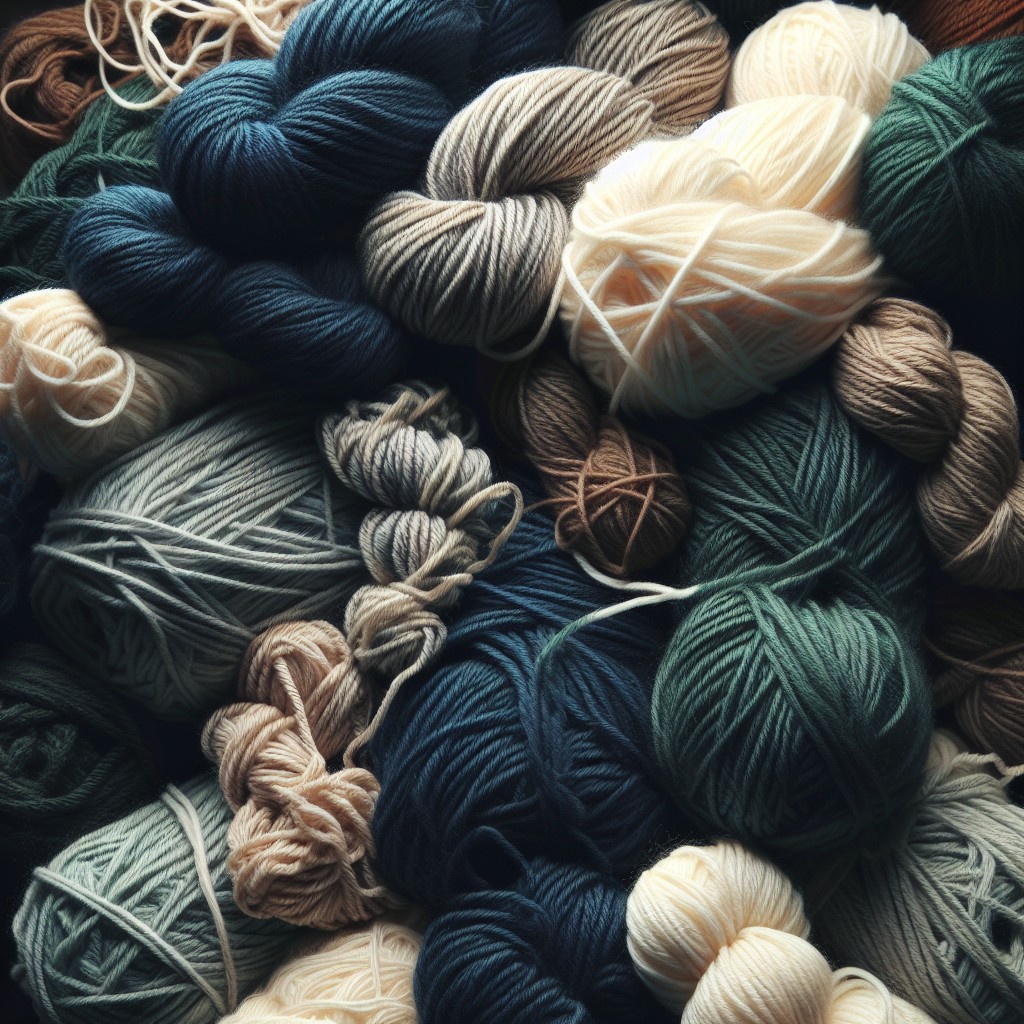Discover the fascinating world of yarn numbers as we delve into various types, unraveling their unique characteristics and applications in textile production.
Are you tired of feeling confused and overwhelmed when it comes to choosing the right yarn for your knitting or crocheting project? Look no further! Understanding yarn weight and numbers is essential for selecting the perfect yarn for your next creation. In this article, we will explore the different types of yarn numbers and what they mean, so you can confidently choose the right yarn for your project.
Whether you’re a beginner or an experienced crafter, this guide will help demystify the world of yarn weights and make your next crafting adventure a success. So grab a cup of tea, sit back, and let’s dive into the world of yarn numbers!
Lace Weight

Lace weight yarn is the finest and lightest of all yarn weights. It is perfect for creating delicate, intricate designs such as shawls, doilies, and other lacy items.
Lace weight yarn typically has a gauge of 8 or more stitches per inch on US size 0-3 needles (2-3.25mm). Due to its fine texture, it requires patience and skill to work with but produces stunning results.
When shopping for lace weight yarns, you will find that they are often made from luxurious fibers such as silk or cashmere which add an extra touch of elegance to your finished project. Some popular brands include Malabrigo Lace Yarn and Madelinetosh Prairie Yarn.
If you’re new to working with lace weight yarns or looking for inspiration on what projects you can create using this type of thread – don’t worry! There are plenty of resources available online including patterns specifically designed for laceweight threads that will help guide you through the process step by step.
Super Fine – Fingering or Sock

It’s a popular choice among knitters who enjoy intricate lacework because of its fine texture. Superfine yarns are usually made from natural fibers like wool or cotton but can also be blended with synthetic materials to add strength and durability.
When shopping for super fine yarns, look out for labels that indicate the number 1 on the label. This indicates that it falls under this category of yarn weights.
Some common brands include Malabrigo Sock Yarn and Knit Picks Stroll Glimmer.
Understanding different types of yarn numbers is crucial in selecting the right type of fiber to use in your knitting or crocheting project.
Fine Weight – Sport

It’s perfect for lightweight garments, such as summer tops or baby clothes. This type of yarn is also great for colorwork projects because it creates a smooth fabric with excellent stitch definition.
The recommended needle size for sport weight yarn ranges from 3.25mm to 3.75mm, making it slightly thicker than fingering but thinner than DK.
When shopping for sport-weighted yarn, look out for labels that indicate “sport” or “fine” on them to ensure you’re getting the right type of fiber thickness needed in your project.
Light Weight – Double Knit (DK Yarn)

It’s slightly heavier than sport weight yarn but lighter than worsted weight. This makes it perfect for creating lightweight garments such as sweaters, cardigans, and shawls.
One of the benefits of using DK weight yarn is that it creates a beautiful drape in your finished project. The fabric created by this type of yarn has enough structure to hold its shape while still being soft and flexible.
Another advantage of using double knit or DK-weighted wool is that it comes in an array of colors making it easy to find the perfect shade for your project. Whether you’re looking for bright hues or muted tones, there’s sure to be something available that will suit your needs.
When working with double-knit woolen threads on larger needles or hooks can create an openwork effect which adds texture and interest to any pattern.
Medium Weight – Worsted and Aran

These types of yarn are versatile, making them a popular choice for many knitting projects.
Worsted is slightly thinner than aran but thicker than DK. It’s perfect for creating warm sweaters, hats, scarves as well as blankets.
The texture of worsted wool makes it ideal for cables and textured stitches.
Aran is a bit thicker than worsted weight; it’s great to use when you want your project to be cozy yet not too heavy. This type of wool works well with patterns that require more structure like cardigans or jumpers.
When choosing between these two types of medium-weight yarns consider what you’re going to make with them first before deciding which one will work best for your project needs.
Bulky Weight
It’s thicker than medium-weight yarn, making it perfect for chunky scarves, hats, blankets and other winter accessories. Bulky weight yarn typically has a gauge of 12-15 stitches per four inches on size US 9-11 needles or larger.
One of the benefits of using bulky weight yarn is that it works up quickly due to its thickness. This makes it an ideal choice if you’re looking to complete your project in a short amount of time or need something quick as a gift idea.
However, keep in mind that because bulky weight yarn is thicker than other types of weights; you’ll need fewer stitches overall when working with this type compared to lighter weights like lace or fingering. When choosing your next project with bulky-weighted-yarns consider what kind texture would be best suited for the pattern since some patterns may not work well with bulkier textures while others are designed specifically around them.
Super Bulky
It is also known as jumbo or roving weight, and it’s perfect for creating quick projects like blankets, scarves, hats and other cozy accessories. Super bulky yarns are usually made from natural fibers such as wool or alpaca to provide warmth during cold weather.
When working with super bulky yarns, you’ll need larger needles or hooks to accommodate its thickness. The recommended needle size for this type of yarn ranges from US 13 (9mm) up to US 19 (15mm).
Due to its thickness and density, super bulky can be challenging for beginners who may find it difficult to maintain an even tension throughout their work.
Despite these challenges though, there are many benefits that come with using super bulky weight in your projects. For one thing – they knit up quickly! This means you can create a project within hours instead of days or weeks which makes them ideal if you’re looking for instant gratification when crafting.
Jumbo
It is also known as roving or giant yarn, and it’s perfect for creating chunky blankets, rugs, and other home decor items. Jumbo yarn has a gauge of fewer than three stitches per inch on size 15 needles or larger.
Due to its thickness, jumbo yarn can be challenging to work with if you’re not used to working with such bulky fibers.
However, once you get the hang of it, jumbo knitting can be incredibly satisfying! The finished product will have a unique texture that adds warmth and coziness to any room in your house.
When choosing jumbo weight yarn for your project make sure that you select one made from high-quality materials like wool or alpaca because they are more durable than synthetic fibers. Also keep in mind that due to its thickness this type of fiber requires special care when washing; hand-washing is recommended over machine washing.
The Standard Yarn Weight System
This system was developed by the Craft Yarn Council of America to provide a universal language for knitters, crocheters, weavers, and other fiber artists to communicate about yarn weights. The standard divides yarn into seven categories ranging from lace weight (the thinnest) to jumbo (the thickest).
Each category has its own recommended needle or hook size range as well as suggested gauge ranges.
Understanding the Standard Yarn Weight System can help you choose the right type of yarn for your project with ease. By knowing which category your desired pattern requires, you can easily find suitable options at any craft store or online retailer.
It’s important to note that while this system provides general guidelines for selecting appropriate types of yarns based on their thickness and weight; it doesn’t account for variations in texture or fiber content. Therefore it’s always essential to check individual labels before purchasing any particular brand/type of wool.
Why Standards Matter
Well, for starters, they ensure consistency in the industry and make it easier for crafters to choose the right yarn for their projects. Without these standards, there would be confusion about what constitutes a particular weight of yarn.
Following standard guidelines ensures that patterns are accurate and produce consistent results across different brands of yarn. This is especially important when working on complex projects or garments where gauge (the number of stitches per inch) is critical.
Moreover, adhering to standardized weights helps manufacturers create products that meet customer expectations regarding texture and drape. For example, lace-weight yarns are typically used in delicate shawls or doilies because they have a light airy feel while bulky-weight ones work well for warm winter hats or scarves due to their thickness.
Determining Yarn Weight
The weight of a yarn refers to how thick or thin it is, and this can greatly affect the outcome of your project. Determining the weight of a particular yarn can be tricky, but there are several ways you can do it.
Firstly, check the label on your skein or ball of yarn. Most manufacturers will include information about their product’s weight on its packaging.
This may be listed as a number from 0-7 (with 0 being laceweight and 7 being jumbo), or as descriptive terms such as “worsted” or “bulky.”.
Another way to determine yarn weight is by wrapping it around a ruler and counting how many wraps per inch (WPI) you get. You can then compare this number with standard WPI measurements for different weights.
If all else fails, you can always use trial-and-error swatching! Make small samples using different needle sizes until you achieve the desired gauge for your pattern.
Yarn Weights
They determine the thickness and density of the yarn, which in turn affects how your finished product will look and feel. The weight of a yarn is determined by its thickness, measured in wraps per inch (WPI), as well as its ply or number of strands twisted together to form a single strand.
The Craft Yarn Council has established a standard system for categorizing yarn weights based on their WPI and ply. This system includes eight categories ranging from lace weight to jumbo weight, with each category having specific characteristics that make it suitable for different types of projects.
Understanding these categories can help you choose the right type of yarn for your project while also ensuring that you achieve consistent results every time you knit or crochet.
Understanding yarn weights is crucial when selecting materials for your next knitting or crocheting project.
YARN WEIGHTS: WHAT DOES IT REALLY MEAN?
It determines how thick or thin the yarn is and can affect everything from stitch definition to drape. But what do these numbers really mean? Yarn weight refers to the thickness of a strand of yarn, which affects its overall bulkiness and density.
The higher the number, the thicker and heavier it will be; conversely, lower numbers indicate thinner strands that are lighter in weight.
The standard system used by most manufacturers categorizes yarn weights into eight categories: lace-weight, super fine (fingering or sock), fine (sport), light (double knit/DK), medium (worsted/aran), bulky, super bulky and jumbo. Understanding these different types of weights can help you choose not only suitable materials but also appropriate hook sizes for your projects.
YARN WEIGHTS: WHY IS IT SO IMPORTANT?
It determines the thickness of the yarn and affects how your finished product will look, feel, and drape. Using a different weight than what’s recommended in a pattern can result in an ill-fitting or distorted final product.
Understanding yarn weights also helps you choose appropriate needles or hooks for your project. A thicker yarn requires larger needles/hooks while thinner ones require smaller sizes.
Moreover, knowing about standard yarn weights makes it easier to substitute one type of fiber with another without compromising on gauge or texture.
YARN WEIGHTS: FROM CRAFT YARN COUNCIL
They have created a standardized system to help crafters choose the right yarn for their projects. The CYC’s standard includes eight different categories of yarn weight, ranging from lace weight to jumbo.
Each category has its own recommended gauge range and hook or needle size, making it easier for crafters to select the appropriate materials based on their project needs. For example, lace-weight yarns are typically used with smaller needles or hooks and produce delicate fabrics suitable for shawls or doilies.
On the other hand, bulky and super-bulky weight yarns require larger needles/hooks but work up quickly into cozy blankets or warm winter accessories like hats and scarves.
Understanding these standardized categories can save you time when shopping online as many retailers list this information alongside each product description. It also ensures that your finished project will turn out as expected since you’ll be using materials suited specifically to your pattern requirements.
YARN WEIGHTS: COMMON NAMES
For example, a yarn labeled as “sport” in one brand may be called “light worsted” in another. To make things even more complicated, some brands use their own unique names for their yarn weights.
Despite these variations, there are common names that most crafters recognize and use when referring to specific types of yarn weights. These include lace weight (the thinnest), fingering or sock weight (super fine), sport weight (fine), double knit or DK (lightweight), worsted and aran (medium-weight) and bulky or chunky.
It’s important to note that while these common names provide a general idea of the thickness of the yarn, they don’t always correspond exactly with standard measurements like wraps per inch or ply count. That’s why it’s essential to check each brand’s recommended gauge on your pattern before selecting your desired type of wool.
YARN WEIGHTS: PLY & WHAT DOES IT MEAN?
Ply refers to the number of strands twisted together to make a single strand of yarn. The more plies a yarn has, the thicker and stronger it will be.
For example, a 2-ply yarn means two strands are twisted together while a 4-ply means four strands are combined. However, keep in mind that ply does not always determine the thickness or weight of the finished product as other factors such as fiber content and twist can also affect this.
It’s important to note that different countries have their own standards for describing ply which can lead to confusion when purchasing from international sources. In general though, most commercial patterns use standard terms like lace-weight or worsted-weight instead of referring directly by its number of plies.
YARN WEIGHTS: WRAPS PER INCH (WPI)
This method involves wrapping the yarn around a ruler or WPI tool and counting how many times it fits within an inch. The number of wraps per inch can help you identify whether your yarn falls into the lace, fingering, sport, worsted or bulky category.
For example, if your yarn measures 18-20 WPI then it’s considered lace weight; 14-16 WPI is super fine – fingering or sock; 12-14 WPI is fine weight – sport; 11-13 WIP light-weight double knit (DK); while medium-weight worsted and aran fall between eight to ten wraps per inch. Bulky weights range from six to seven Wraps Per Inch while Super Bulky has five-six Wraps Per Inch.
Jumbo Yarns have less than four Wraps Per Inch.
Knowing how many wraps-per-inch will also help you substitute one type of wool for another in patterns that don’t specify exact brands but instead give gauge information as well as stitch counts.
YARN WEIGHTS: AN OVERVIEW
They determine the thickness and density of the yarn, which in turn affects how your finished product will look and feel. The standard yarn weight system is a helpful tool that categorizes different types of yarn based on their thickness, making it easier for crafters to choose the right one for their project.
The standard system includes eight categories ranging from lace weight to jumbo. Lace weight is incredibly thin and delicate, while jumbo is thick and chunky.
In between these two extremes are super fine (also known as fingering or sock), fine (sport), light (double knit or DK), medium (worsted/aran) bulky, and super bulky.
Each category has its own unique characteristics that make it suitable for specific projects such as shawls, socks sweaters blankets hats scarves etcetera. Understanding these categories can help you select appropriate patterns designed specifically with each type in mind.
In conclusion understanding Yarn Weights: An Overview helps you understand what kind of projects work best with each type so you can confidently choose the perfect yarn every time!.
FAQ
What does 8 8 or 8 4 mean in yarn?
In yarn, 8/4 and 8/8 represent the thickness and ply of cotton yarn, with the first number indicating thickness and the second number indicating the number of strands or yarn fibers spun together.
What is the difference between #3 and #4 yarn?
The difference between #3 and #4 yarn is that #3 is a light yarn used for garments and heavier baby items, while #4 is a medium yarn commonly used for various projects like Afghans and Arans.
What does #5 yarn mean?
Yarn weight #5, also known as bulky weight yarn, refers to a category that includes chunky, craft, and rug yarn types.
What does #4 yarn mean?
Answer: A #4 yarn means that the yarn has a medium weight, as indicated by the thickness number ranging from 0 to 6.
How do yarn numbers affect the thickness and weight of the final fabric?
Yarn numbers directly influence the thickness and weight of the final fabric, as higher yarn numbers result in finer, thinner, and lighter fabric, while lower yarn numbers produce thicker, heavier fabric.
How can yarn numbers help determine the appropriate knitting or crocheting needle size to use?
Yarn numbers help determine the appropriate knitting or crocheting needle size to use by indicating the thickness of the yarn, allowing for the selection of a suitable needle for consistent stitch size and tension.
What are some common projects suitable for different yarn number categories?
Common projects suitable for different yarn number categories include fine yarns for delicate items like lace shawls, medium yarns for garments like sweaters, and thick yarns for home accessories like blankets.





